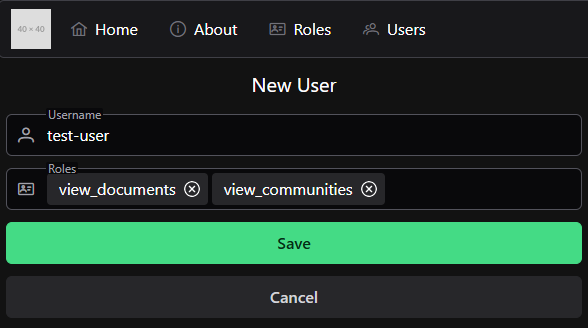New User
Creating a New User
Now that we have a nice way to edit a user account, we’d like to also have a way to create a new user account. While we could easily duplicate our work in the UserEdit component and create a UserNew component, we can also add a bit more logic to our UserEdit component to handle both cases. So, let’s look at how we can do that!
First, we’ll need to add a route to our project to get us to the correct place. So, we’ll update our Vue Router:
// -=-=- other code omitted here -=-=-
const router = createRouter({
// Configure History Mode
history: createWebHistory(import.meta.env.BASE_URL),
// Configure routes
routes: [
// -=-=- other code omitted here -=-=-
{
path: '/users/new',
name: 'newuser',
component: () => import('../views/UsersEditView.vue'),
beforeEnter: requireRoles('manage_users'),
},
],
})
// -=-=- other code omitted here -=-=-
This route will take us to the UsersEditView view, but without a prop giving the ID of the user to edit. When we get to that page without a prop, we’ll assume that the user is intending to create a new user instead. So, we’ll need to change some of our code in that component to handle this gracefully.
Thankfully, we can just look at the value of props.id for this - if it is a falsy value, then we know that it wasn’t provided and we are creating a new user. If one is provided, then we are editing a user instead.
So, at the start, if we are creating a new user, we want to set our user reactive state variable to a reasonable default value for a user. If we are editing a user, we’ll request that user’s data from the server.
<script setup>
// -=-=- other code omitted here -=-=-
// Load Users
if (props.id) {
api
.get('/api/v1/users/' + props.id)
.then(function (response) {
user.value = response.data
})
.catch(function (error) {
console.log(error)
})
} else {
// Empty Value for User Object
user.value = {
username: '',
roles: []
}
}
// -=-=- other code omitted here -=-=-
</script>Then, we need to change the code for saving a user to handle both situations. Thankfully, we can adjust both the method (either POST or PUT) as well as the URL easily in Axios using the Axios API.
<script setup>
// -=-=- other code omitted here -=-=-
// Save User
const save = function () {
errors.value = []
let method = 'post'
let url = '/api/v1/users'
if (props.id) {
method = 'put'
url = url + '/' + props.id
}
api({
method: method,
url: url,
data: user.value
}).then(function (response) {
if (response.status === 201) {
toast.add({
severity: 'success',
summary: 'Success',
detail: response.data.message,
life: 5000,
})
router.push({ name: 'users' })
}
})
.catch(function (error) {
if (error.status === 422) {
toast.add({
severity: 'warn',
summary: 'Warning',
detail: error.response.data.error,
life: 5000,
})
errors.value = error.response.data.errors
} else {
toast.add({ severity: 'error', summary: 'Error', detail: error, life: 5000 })
}
})
}
</script>Since both the POST and PUT operations will return the same style of errors, the rest of the code is identical!
Finally, in our template, we can include a bit of conditional rendering to display whether we are creating a new user or editing an existing user:
<template>
<div class="flex flex-col gap-3 max-w-xl justify-items-center">
<h1 class="text-xl text-center m-1">{{ props.id ? "Edit User" : "New User" }}</h1>
<!-- other code omitted here -->
</div>
</template>That’s really all the changes we need to make to allow our UserEdit component to gracefully handle both editing existing users and creating new users!
